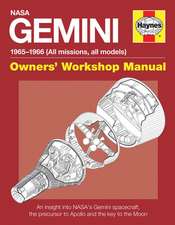Water and the Search for Life on Mars: Springer Praxis Books
Autor David M. Harlanden Limba Engleză Paperback – 14 noi 2005
David Harland considers the issue of life on Mars in parallel with the origin of life on Earth. At the time the Viking instruments were designed, it was thought that all terrestrial life ultimately derived its energy from sunlight, and that the earliest form of life was the cyanobacteria with chlorophyll for photosynthesis. It was assumed the same would be the case on Mars and that microbial life would be on or near the surface that the Vikings had sampled.
In parallel with these NASA projects, the European Space Agency developed the Mars Express remote-sensing orbiter, which has detected traces of methane that may have been released by microbes. If microbial life is found on Mars, will it be based on DNA? Will this indicate that life developed independently? Or that it has characteristics in common with the most ancient forms of terrestrial life? If life is found on two planets in the same planetary system, this would favour the panspermia hypothesis. And if martian life is radically different, then in light of the discovery of planetary systems around other stars, this would, as remarked by Philip Morrison of MIT, "transform life from the status of a miracle to that of a statistic". These are all questions that the exploration of Mars for life are aimed to answer.
Din seria Springer Praxis Books
-
 Preț: 294.46 lei
Preț: 294.46 lei -
 Preț: 223.45 lei
Preț: 223.45 lei -
 Preț: 167.85 lei
Preț: 167.85 lei -
 Preț: 288.98 lei
Preț: 288.98 lei -
 Preț: 323.74 lei
Preț: 323.74 lei -
 Preț: 401.38 lei
Preț: 401.38 lei -
 Preț: 264.12 lei
Preț: 264.12 lei - 8%
 Preț: 513.00 lei
Preț: 513.00 lei -
 Preț: 190.01 lei
Preț: 190.01 lei -
 Preț: 218.16 lei
Preț: 218.16 lei -
 Preț: 312.06 lei
Preț: 312.06 lei - 17%
 Preț: 414.05 lei
Preț: 414.05 lei -
 Preț: 216.41 lei
Preț: 216.41 lei -
 Preț: 262.27 lei
Preț: 262.27 lei -
 Preț: 264.35 lei
Preț: 264.35 lei -
 Preț: 167.63 lei
Preț: 167.63 lei -
 Preț: 284.81 lei
Preț: 284.81 lei -
 Preț: 259.08 lei
Preț: 259.08 lei -
 Preț: 305.47 lei
Preț: 305.47 lei -
 Preț: 244.14 lei
Preț: 244.14 lei -
 Preț: 227.85 lei
Preț: 227.85 lei -
 Preț: 285.25 lei
Preț: 285.25 lei -
 Preț: 295.56 lei
Preț: 295.56 lei -
 Preț: 357.17 lei
Preț: 357.17 lei -
 Preț: 275.79 lei
Preț: 275.79 lei -
 Preț: 257.08 lei
Preț: 257.08 lei -
 Preț: 349.71 lei
Preț: 349.71 lei -
 Preț: 272.45 lei
Preț: 272.45 lei -
 Preț: 270.27 lei
Preț: 270.27 lei - 8%
 Preț: 456.51 lei
Preț: 456.51 lei -
 Preț: 352.34 lei
Preț: 352.34 lei - 8%
 Preț: 394.80 lei
Preț: 394.80 lei -
 Preț: 320.65 lei
Preț: 320.65 lei -
 Preț: 325.29 lei
Preț: 325.29 lei -
 Preț: 253.11 lei
Preț: 253.11 lei -
 Preț: 192.86 lei
Preț: 192.86 lei -
 Preț: 313.40 lei
Preț: 313.40 lei -
 Preț: 150.51 lei
Preț: 150.51 lei -
 Preț: 233.34 lei
Preț: 233.34 lei -
 Preț: 286.78 lei
Preț: 286.78 lei -
 Preț: 212.01 lei
Preț: 212.01 lei -
 Preț: 366.83 lei
Preț: 366.83 lei -
 Preț: 299.99 lei
Preț: 299.99 lei -
 Preț: 232.27 lei
Preț: 232.27 lei -
 Preț: 284.58 lei
Preț: 284.58 lei -
 Preț: 212.45 lei
Preț: 212.45 lei -
 Preț: 159.81 lei
Preț: 159.81 lei -
 Preț: 349.48 lei
Preț: 349.48 lei - 20%
 Preț: 2061.64 lei
Preț: 2061.64 lei
Preț: 193.12 lei
Nou
Puncte Express: 290
Preț estimativ în valută:
36.96€ • 40.13$ • 31.04£
36.96€ • 40.13$ • 31.04£
Carte disponibilă
Livrare economică 01-15 aprilie
Preluare comenzi: 021 569.72.76
Specificații
ISBN-13: 9780387260204
ISBN-10: 038726020X
Pagini: 239
Ilustrații: XIX, 239 p. 162 illus.
Dimensiuni: 240 x 170 x 15 mm
Greutate: 0.54 kg
Ediția:2005
Editura: Springer
Colecția Praxis
Seria Springer Praxis Books
Locul publicării:New York, NY, United States
ISBN-10: 038726020X
Pagini: 239
Ilustrații: XIX, 239 p. 162 illus.
Dimensiuni: 240 x 170 x 15 mm
Greutate: 0.54 kg
Ediția:2005
Editura: Springer
Colecția Praxis
Seria Springer Praxis Books
Locul publicării:New York, NY, United States
Public țintă
ResearchCuprins
Peering at Mars.- A close look.- The Vikings.- What is life?.- A multiplicity of missions.- The water dilemma.- Spirit.- Opportunity.- Future prospects.
Recenzii
From the reviews:
"David Harland’s book is well times, as he succinctly sums up the history of Mars exploration, linking together the early telescopic observational stuff with the modern, represented by the wildly successful Sprit and Opportunity rovers…There’s also a highly informative section on the chemical basis of life, in which we learn about the extremophiles that live next to hot thermal vents on the Earth’s sea bed… Approximately 230 well-labelled and informative pictures and dozens of diagrams alone make the book good value, and one feels again some of the excitement when reading over the last 60 pages about the landings and explorations of the US Spirit and opportunity… His fine interpretations of how it all hangs together to paint a picture of an ancient Martian history in which large standing bodies of water almost certainly exited on the planet makes a book that anyone interested in Mars should have." Steve Tidey (Astronomy Now)
"This is a typical David Harland book - lots to praise … . Narrowly focussed, it covers man’s progress in understanding the nature of the red planet, Mars, and whether it has, or once had, liquid water and perhaps life. It is written in an easy style and flows nicely in spite of the comprehensive detail. … The book is well illustrated with monochrome drawings and sketches, especially of spacecraft." (Roger Feasey, AAS Journal, September, 2006)
"The book is organized as an historical review of observations and theories about Mars from telescopic observation, followed by a chronological description of Mars exploration from space probes. The historical section is full of fascinating information, with many stories … that give a detailed background as to the state of knowledge of Mars up to the start of the space race and how it was obtained. … there is a wealth of detail and many interesting anecdotes." (The Observatory, Vol. 126 (1195), December, 2006)
"The prolific MrHarland has come up with a real winner in this slim but highly readable volume. … The book is profusely illustrated with maps and photos from the various missions, and there is even a very nice selection of colour plates, particularly of the spectacular views from the rovers. This really is a very fine book, and anyone interested in Mars exploration would get much out of it." (Liftoff, Issue 233, May/June, 2006)
"David Harland’s book is well times, as he succinctly sums up the history of Mars exploration, linking together the early telescopic observational stuff with the modern, represented by the wildly successful Sprit and Opportunity rovers…There’s also a highly informative section on the chemical basis of life, in which we learn about the extremophiles that live next to hot thermal vents on the Earth’s sea bed… Approximately 230 well-labelled and informative pictures and dozens of diagrams alone make the book good value, and one feels again some of the excitement when reading over the last 60 pages about the landings and explorations of the US Spirit and opportunity… His fine interpretations of how it all hangs together to paint a picture of an ancient Martian history in which large standing bodies of water almost certainly exited on the planet makes a book that anyone interested in Mars should have." Steve Tidey (Astronomy Now)
"This is a typical David Harland book - lots to praise … . Narrowly focussed, it covers man’s progress in understanding the nature of the red planet, Mars, and whether it has, or once had, liquid water and perhaps life. It is written in an easy style and flows nicely in spite of the comprehensive detail. … The book is well illustrated with monochrome drawings and sketches, especially of spacecraft." (Roger Feasey, AAS Journal, September, 2006)
"The book is organized as an historical review of observations and theories about Mars from telescopic observation, followed by a chronological description of Mars exploration from space probes. The historical section is full of fascinating information, with many stories … that give a detailed background as to the state of knowledge of Mars up to the start of the space race and how it was obtained. … there is a wealth of detail and many interesting anecdotes." (The Observatory, Vol. 126 (1195), December, 2006)
"The prolific MrHarland has come up with a real winner in this slim but highly readable volume. … The book is profusely illustrated with maps and photos from the various missions, and there is even a very nice selection of colour plates, particularly of the spectacular views from the rovers. This really is a very fine book, and anyone interested in Mars exploration would get much out of it." (Liftoff, Issue 233, May/June, 2006)
Textul de pe ultima copertă
"Why explore Mars? The simple answer is, we’re going to Mars to search for life. We’re following the water because on Earth where you find liquid water, organic material, and energy, you find life." u find life"
Ed Weiler, NASA's Associate Administrator for Space Science
Ear where you find liquid water,
A century ago, the world was enthralled by Percival Lowell’s vision of a Mars criss-crossed with the canals of a dying civilization distributing water from the polar caps. Later, Mars was thought to have been cold, dead and dry for eons, but striking new evidence suggests the planet was relatively warm and wet in geologically recent times, and that even now there are reserves of water frozen beneath the planet’s surface.
Today, robot spacecraft maneuver across the Martian surface while others orbit overhead seeking evidence of water, ice, and landing sites for further exploration. In recent years, the very possibilities for life have dramatically expanded as discoveries by biologists and oceanographers have revealed bizarre life forms where none would have been expected. And as the growing evidence that water flowed on Mars becomes indisputable, more spacecraft are soon to follow.
This highly absorbing book relates how NASA and ESA have sought evidence of life on Mars. ‘Follow the water’ with noted science writer David Harland as he assembles and weighs the evidence in this timely and compelling book. It contains what you need to know behind today’s, and possibly tomorrow’s, headlines, including details of the Mariner, Viking, and Pathfinder missions and evolving theories of Martian geology and climate. It explains how the search accelerates with the Mars Orbiter and Mars Exploration Rovers Spirit and Opportunity. Harland sets this within the broader perspective of the likely nature of life on Mars as compared to primitive life on Earth. Finally, he analyzes the implications of there beinglife on both planets. Join the scientific adventure of a lifetime in this well-researched and thoroughly engrossing true account.
Ed Weiler, NASA's Associate Administrator for Space Science
Ear where you find liquid water,
A century ago, the world was enthralled by Percival Lowell’s vision of a Mars criss-crossed with the canals of a dying civilization distributing water from the polar caps. Later, Mars was thought to have been cold, dead and dry for eons, but striking new evidence suggests the planet was relatively warm and wet in geologically recent times, and that even now there are reserves of water frozen beneath the planet’s surface.
Today, robot spacecraft maneuver across the Martian surface while others orbit overhead seeking evidence of water, ice, and landing sites for further exploration. In recent years, the very possibilities for life have dramatically expanded as discoveries by biologists and oceanographers have revealed bizarre life forms where none would have been expected. And as the growing evidence that water flowed on Mars becomes indisputable, more spacecraft are soon to follow.
This highly absorbing book relates how NASA and ESA have sought evidence of life on Mars. ‘Follow the water’ with noted science writer David Harland as he assembles and weighs the evidence in this timely and compelling book. It contains what you need to know behind today’s, and possibly tomorrow’s, headlines, including details of the Mariner, Viking, and Pathfinder missions and evolving theories of Martian geology and climate. It explains how the search accelerates with the Mars Orbiter and Mars Exploration Rovers Spirit and Opportunity. Harland sets this within the broader perspective of the likely nature of life on Mars as compared to primitive life on Earth. Finally, he analyzes the implications of there beinglife on both planets. Join the scientific adventure of a lifetime in this well-researched and thoroughly engrossing true account.
Caracteristici
Provides a comprehensive account of the recent ‘Spirit’ and ‘Opportunity’ Mars Exploration Rover missions Relates how NASA/ESA have sought evidence of life on Mars, with the prevailing mood sometimes being optimistic and sometimes pessimistic Details an account of the rationale for the tests for life carried out by the Viking missions in 1976, with an account of the debate over their results A concise primer for readers wishing to ‘bone up’ when NASA next sends a lander explicitly to seek life on Mars Discusses the nature of life on Mars in terms of the most primitive forms of life on Earth, and reviews the implications of there being life on both planets



















